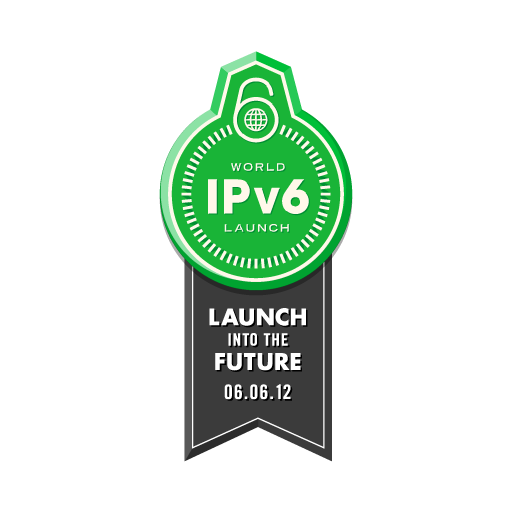World IPv6 Launch
Pending the imminent exhaustion of available IP addresses on the current IPv4 Internet, many large Internet web sites have come together and agreed that they will be switching on IPv6 permanently.
This means many websites are now available over both the current IPv4 Internet and the new IPv6 Internet. But what does this actually mean for Internet users? Hopefully you won’t even notice a difference. You can find out more about who is involved here: http://www.worldipv6launch.org
What is IPv4 Exhaustion and IPv6
All devices connected to the internet have what is known as an IP Address or an Internet Protocol Address. These addresses on the Internet must be unique and be assigned to any web server, router, or computer on the Internet. The current version of IP which has addresses which look like 80.68.48.12 for example is known as IPv4.
IPv4 theoretically has 4,294,967,296 maximum addresses, this may sound like a lot but they’re almost all gone already. To allow for continued Internet growth the Internet Engineering Task Force (IETF) has had to expand the maximum number of addresses but since IPv4 has been hard coded into billions of devices all over the world, a new protocol called IPv6 has been developed.
IPv6 theoretically has, wait for it: 340,282,366,920,938,463,463,374,607,431,768,211,456! Which is pronounced 340 undecillion, 282 decillion, 366 nonillion, 920 octillion, 938 septillion, 463 sextillion, 463 quintillion, 374 quadrillion, 607 trillion, 431 billion, 768 million, 211 thousand and 456.
This means each individual user could be supplied with more IP addresses than the original IPv4 specification ever had, in fact, each person on earth could have trillions of addresses for themselves. So while this solves the address problem what it doesn’t solve is actually getting the Internet moved over to IPv6.
IPv6 was developed back in the 90’s but has had slow adoption as most people have been working fine on IPv4 and until most things are available on IPv6, they didn’t see the point of implementing it across the network until everyone else did it, which means nobody did it.
However over the last couple of years the IPv4 address pool has started to feel the squeeze. IP addresses are allocated in blocks then split into smaller blocks and eventually allocated to end users.
The IANA (Internet Assigned Numbers Authority) is responsible for delegating large chunks of IP addresses to regional authorities. These authorities deal directly with the ISP’s located in a global region. On the 31st of January 2011 the last IP addresses were allocated by the IANA to the regional authorities. This means once a regional authority runs out of available IPv4 addresses it will no longer be able to allocate new IP addresses to the ISP’s.
RIPE NCC is the authority which covers Europe, the Middle East, and Central Asia. Datanet requests blocks of IP addresses from RIPE NCC and currently holds around 16,500 IPv4 addresses. We aren’t currently using all of our IP addresses allocated to us but if we were to run out, we would need to request more from RIPE NCC. However if RIPE NCC has run out, which is expected to be within the next 18 months, Datanet cannot allocate IPv4 addresses to the customer.
So what initially happens? Well nothing, everyone who is on the Internet now will still be able to access everything; all the web servers which are on the Internet will continue to be available to all these users. However ISP’s will not be able to offer new Internet Connections or host new servers on behalf of customers.
ISP’s will be required to allocate customers only IPv6 Internet addresses. This means native users who are on IPv6 will not be able to access any website which is currently only available on IPv4. Also any new web servers which are setup on IPv6 will not be accessible to end users on IPv4 only.
To stop the Internet from appearing broken is to coexist both IPv4 and IPv6 addresses on all existing users and servers on the Internet. This is known as dual stacking which will allow the current Internet to function over IPv4 and the new IPv6 Internet so slowly grow and replace the existing IPv4 internet.
Datanet’s Preparation
Datanet has been allocated its IPv6 address pool by RIPE NCC. The core of our network is already IPv6 enabled and we are also ensuring that all our interconnections with neighbouring ISP’s are all IPv6 enabled to ensure we can offer as fast and efficient service over IPv6 as we can over IPv4.











